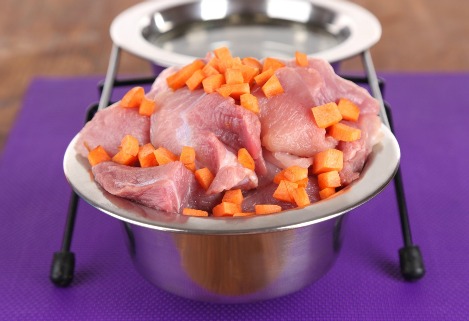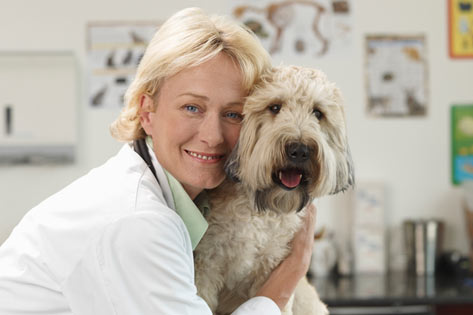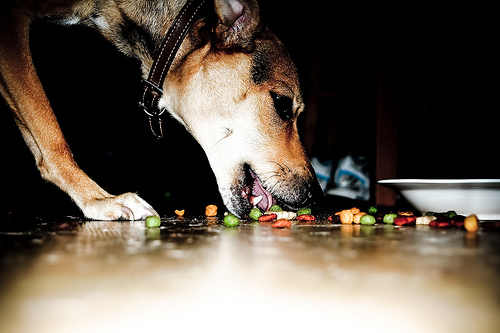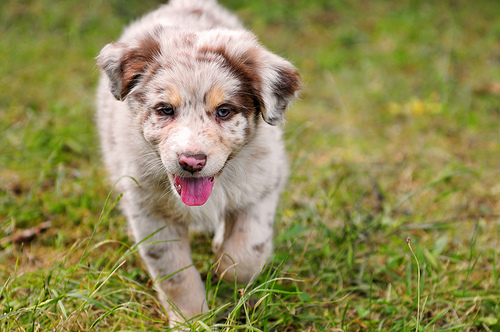

by Teresa Traverse
While you can just go down the street to your local pet store to buy a bag of high-quality dog kibble, many pet parents are now opting not to. Dog food recalls and other safety concerns have many owners exploring the raw dog food trend.
If you’re wondering if feeding your dog raw meat might be the right choice for your four-legged family, use this guide to help you weigh the benefits and risks of a raw food diet for dogs.
Similar to the popular Paleo diet for humans, the raw-food trend for dogs stems from the theory that domestic canines can benefit from following a diet more closely in line to their wolf ancestors, according to Cathy Alinovi, DVM, and owner of Healthy Pawsibilities in Pine Village, Indiana.
Raw dog food diets usually consist entirely of raw meat and produce. Dr. Alinovi cautions against a solely produce-based diet, since dogs need protein to thrive.
You can purchase commercial raw dog food diets from the store, make your own, or, in some communities, purchase raw dog food from butchers.
Tim Marzonie, butcher and owner of Butcher Block Meats in Chandler, Arizona, sells raw dog food to his customers. His beef dog food is a blend of organ meat or hearts, kidneys, liver, and a little beef trim to hold the entire mixture together. His chicken dog food consists of necks and backs with the bones in.
Both Marzonie and Dr. Alinovi caution pet owners to ensure that bones are uncooked if you’re feeding your dogs chicken (or other) bones. Cooked bones can splinter and seriously damage your dog’s digestive track. Marzonie grinds all of the meat products together and sells the raw dog food frozen in 16-ounce cups.
If you’re headed to the butcher to get raw dog food, you’ll want to pick your butcher carefully. You’ll need to ensure the shop is using high-quality ingredients and not putting spoiled meats in the raw dog food mixture. Marzonie says to ask the butcher where the shop is getting its product from, and be sure to tell the butcher that you’re planning on feeding the raw food to your dog before you make the purchase.
Dr. Alinovi says that a raw dog food diet is not for everyone.
If you’re a vegetarian or vegan, handling raw meat is probably not for you. It also takes time to prepare raw food, and you might not have a schedule that allows for the added steps of a raw food diet. In addition, feeding dogs raw food can be more expensive, so it may not be a sustainable diet choice that fits into your budget.
If you do decide to try a raw-food diet with your dog, it’s best to get advice from and work with a certified canine nutritionist or knowledgeable veterinarian. Avoid the following potentially toxic foods if you plan on preparing raw dog food at home:
Dr. Alinovi recommends that all of her clients feed raw food and says she’s seen improvements after switching patients to a raw dog food diet, including a reduction in inflammation, less shedding, and better coat quality. Feeding raw food may also help with pancreatitis or kidney disease, according to Dr. Alinovi.
Raw dog food diets also have their detractors.
“I don’t know of any medical studies that demonstrate any benefits at this time for going raw,” says Kimberly Pate, DVM, and an associate veterinarian at Sunset Veterinary Clinic in Edmond, Oklahoma.
If the meat is contaminated, there’s a chance you or your dog could get an infection. When you work with anything raw, there’s always a potential risk of contracting salmonella, listeria, or other food-borne illnesses. Also, Dr. Pate says, it can be difficult to provide a balanced diet if you aren’t careful about monitoring what goes into your dog’s food.
There’s also a possibility that dogs could crack their teeth on a bone, or that bones might get stuck and/or perforate the intestinal track, Dr. Pate says.
Hygiene is very important when handling raw dog food. Be sure to always wash your hands before and after handling raw meat, says Dr. Alinovi. You’ll also want to avoid cross contamination. After you’ve chopped raw meat on a cutting board, be sure to wash the surface before placing another food on it to decrease the chance of bacteria spreading.
Dr. Alinovi also says to examine the raw dog food to ensure it doesn’t look spoiled.
“If the liver looks like it has abscesses (white tracks, pus pockets), it shouldn’t be fed,” she says.
Whether you’re heading to the store for a commercially prepared raw dog food or you’re sticking to canned food or kibble, there are a few important tips to consider.
Read the labels carefully, says Dr. Pate. If the food is labeled “for intermittent or supplemental feeding only,” it’s not a complete and balanced diet.
You’ll also want to make sure you’re buying food tailored to your dog. If you have a puppy, buy puppy food. If your dog is an adult, be sure to purchase the adult varieties. Pate warns against being drawn into marketing techniques and always recommends working with your veterinarian to determine what’s right for your dog.
You’ll also want to look for foods that meet AAFCO standards. Be sure to look on the bag to see if the company has a veterinary nutritionist on staff.
“Is there a number you can call? Do they give tours of the facility? Does the bag of dog food tell them how much to feed the pet?" asks Dr. Pate. "If you’re not seeing how to feed the pet and you’re not able to contact a nutritionist on staff, those are concerning things,” says Dr. Pate, adding, “when in doubt, ask a veterinarian.”
 The Healthy Ways Vets Take Care of Their Pets
By Jessica Remitz
Just like every other pet owner
The Healthy Ways Vets Take Care of Their Pets
By Jessica Remitz
Just like every other pet owner
 Contrasting Grain-based and Meat-based Diets for Dogs
By T. J. Dunn, Jr., DVM
It is commo
Contrasting Grain-based and Meat-based Diets for Dogs
By T. J. Dunn, Jr., DVM
It is commo
 Enzyme Replacement Therapy for EPI
Exocrine pancreatic insufficiency (EPI) is
Enzyme Replacement Therapy for EPI
Exocrine pancreatic insufficiency (EPI) is
 Your Dog and the Cold Germ
Can My Dog 'Catch' a Cold?
Winter isn&rsqu
Your Dog and the Cold Germ
Can My Dog 'Catch' a Cold?
Winter isn&rsqu
 A Clean Bill of Health
This article is courtesy of AKC Canine Health Foundation.
A Clean Bill of Health
This article is courtesy of AKC Canine Health Foundation.
Copyright © 2005-2016 Pet Information All Rights Reserved
Contact us: www162date@outlook.com